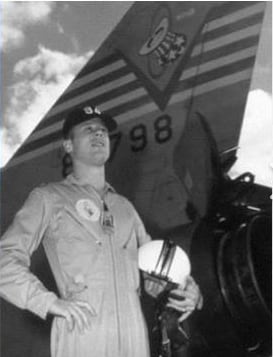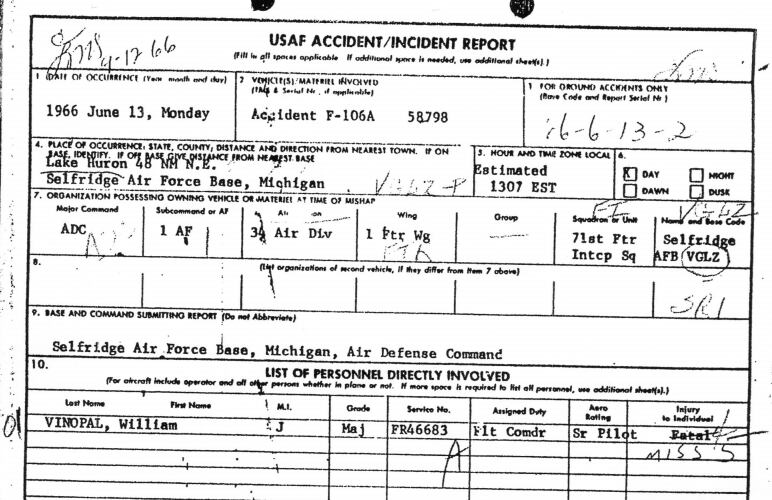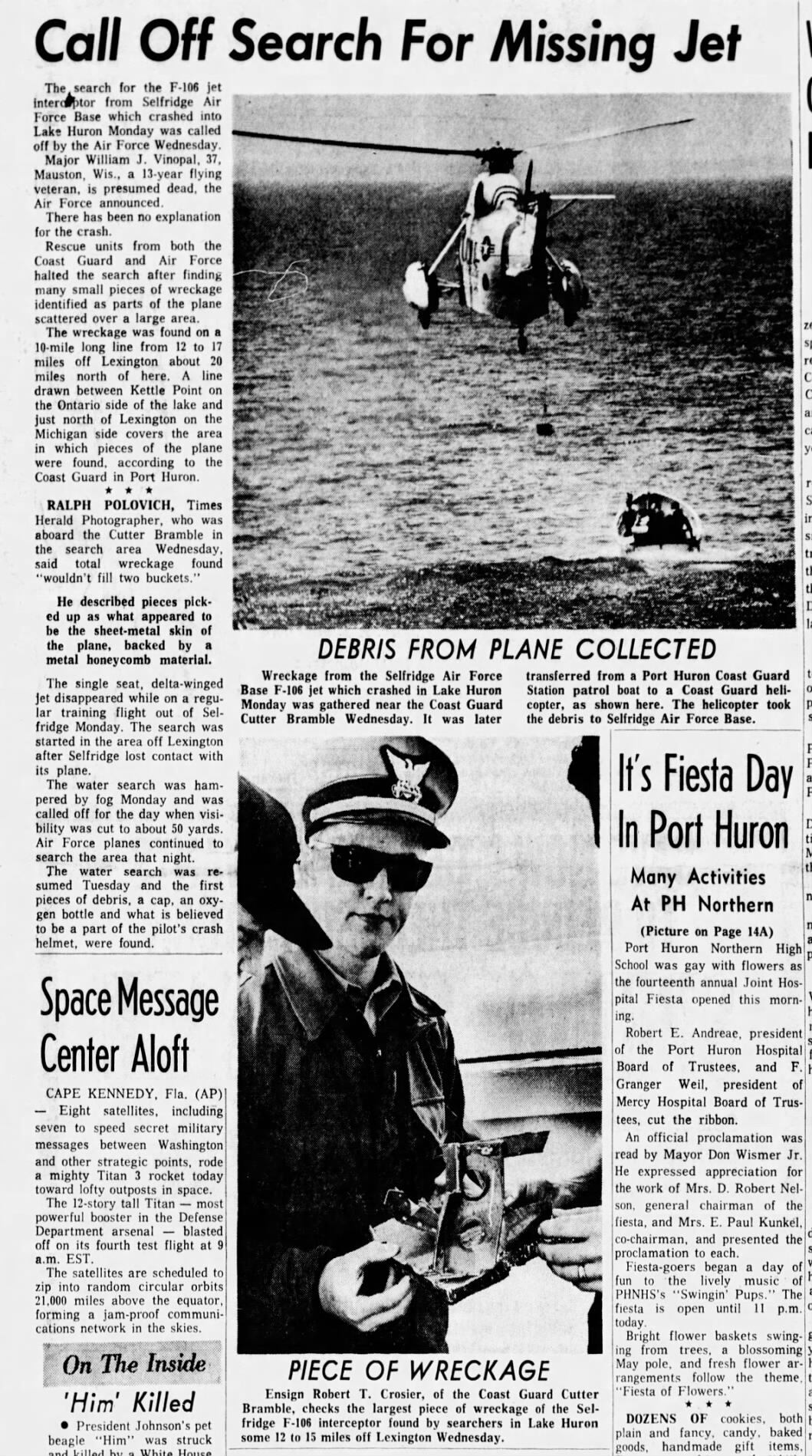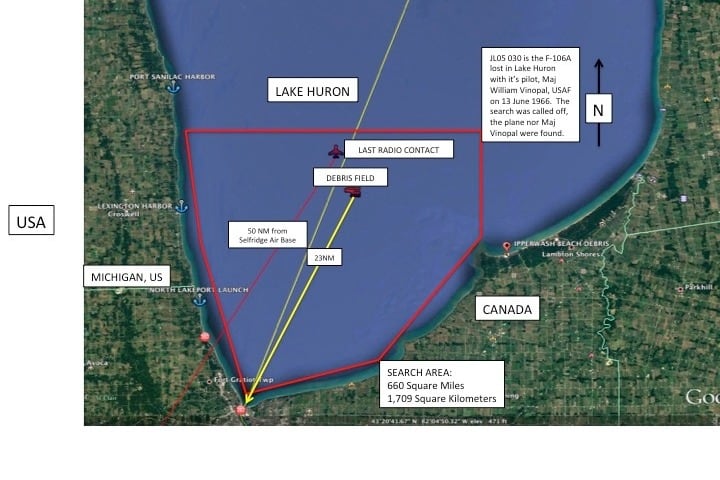On June 13, 1966, a young George Beebe, working on the roof of a hospital, swears he saw a powerless fighter jet gliding low over Lake Huron, a faint trail of smoke following. As it disappears out of his sight, Beebe scrambles to alert the nearby Coast Guard station about a potential downed aircraft.
Hours earlier, U.S. Air Force Maj. William J. Vinopal of the 71st Fighter Interceptor Squadron climbed into his Convair F-106A Delta Dart, a single-seat, flight interceptor aircraft, for a routine training mission over the lake.
It would turn out to be his last flight, and Beebe, a former Air Force jet engineer mechanic himself, may have been one of the last people to see the airman alive.
Now, over 50 years later, a group of veterans – including Beebe, now 85, and his nephew, John – is on a mission to locate the wreckage and recover Vinopal’s remains.

“I could read the writing on his helmet and the four-inch numbers painted on his tail,” George Beebe told WDIV Local 4 in 2018. “We’re just bound and determined that we are going to find him. I just know he’s right here, close to home. All we have to do is find him.”
Along with his uncle George, John Beebe, 56, a retired Michigan Air National Guard technical sergeant, brought together a group of Air Force and Navy veterans, dubbed Lake Huron Exploration, to begin their search around Memorial Day 2017.
“Here’s a guy that never came back to his family, that’s been missing in our own backyard, Lake Huron, for over 50 years,” Beebe told Military Times. “He’s a fellow airman. We’d like to see him returned to his family.”
Vinopal, aged 36, of Mauston, Wisconsin, was a 13-year flying veteran when he took off from Selfridge Air Force Base, near Mount Clemens, Michigan, that June morning. The training exercise involved four other fighter jets and one practice enemy aircraft, a T-33 Shooting Star.

The pilot checked in with his target before officials lost contact with the jet flying at 3,000 feet around 1 p.m. local time, 50 nautical miles from Selfridge over lower Lake Huron.
Despite the presence of Coast Guard cutter Bramble, two helicopters and several Air Force planes, the downed aircraft could not be located, as the search was cut short due to heavy fog in the area.
The next day, small fragments of the plane were spotted, and “a pilot’s helmet pad and blue baseball cap, identified as belonging to Major Vinopal washed ashore 15 miles northeast of Port Huron, according to the official crash report.
On the third day, the search was called off.
Vinopal was assumed dead. He was survived by his wife, Mary Irene, and his three children, Kim, Craig and Kelly. The children were between the ages of nine and six when their father was killed.

In the months following the crash, the Air Force hired Jon Lindbergh, the son of famed aviator Charles Lindbergh, who was also a former diver with the Navy’s Underwater Demolition Team. His search was also unsuccessful, and the cause of the accident remains unclear.
The current all-volunteer crew began their search with John Beebe’s sailing boat and simple, commercial fish-finding gear. After preliminary fundraising efforts, the team purchased a towable sonar device to better map the lake bed.
“I took all the data and figured out the unknown data. We plotted it on a nav chart,” said Donald Maury, a former Navy chief petty officer, who volunteers on the team as research director. “We are going in grids in the areas we suspect through our calculations and the last reports where the aircraft was located.”
News of the search was “hugely important” to the living members of the Vinopal family, Beebe said. “They were thrilled to hear that somebody was looking for their dad, that he wasn’t forgotten.”

Other members of the exploration crew include retired Air Force Lt. Col. Brian Leslie, who serves as the team’s engineer; Jeff Isabell, a former Navy aviation warfare systems operator and the team’s sonar expert; and retired Air Force Senior Master Sgt. Dave Howard.
They have since purchased a used diesel-engine boat, the Sonya Lee, to replace their sailboat and have created a new GoFundMe page to raise additional funds for a high performance underwater rover.
“The purpose for the ROV is that we can’t take divers out with us all the time,” Maury said. “The ROV, you can throw it in the water, get a quick visual. If it’s nothing, you can mark it off and move on.”
Locating the crash site has proven to be difficult, even with the team’s years of advanced military training.
Lake Huron itself covers over 23,000 square miles. While the group has narrowed down their area of operations to 660 square miles, it is still an enormous area to investigate.

The team of veterans, however, remains undeterred.
“We are just trying to bring a brother, a fellow veteran home,” Bebee said. “He was a great guy, serving his country, flying his F-106. And he went missing one day. We want to solve that mystery."
Should the crew locate the wreckage, they will investigate with divers to confirm the presence of Vinopal’s remains. If the remains are co-located with the jet, team members said they will defer to the family to either leave the airman undisturbed or allow the federal government to repatriate his remains.
“It’s just the issue of knowing that there’s a guy still out there somewhere. We are not trying to beat our chests. We are just quietly going about it,” Maury added. “It’s just to bring closure to the family. That’s all John [Beebe] did from the very beginning, and that’s everybody’s attitude on the crew.”
Dylan Gresik is a reporting intern for Military Times through Northwestern University's Journalism Residency program.




